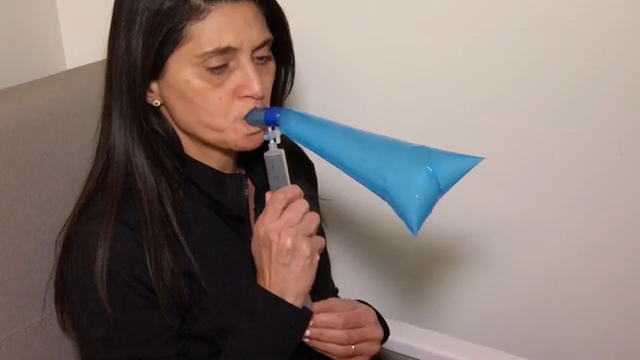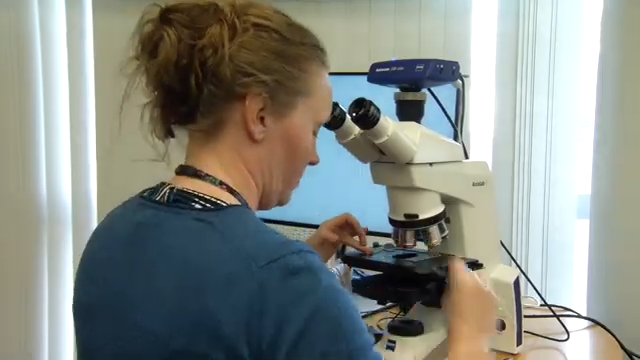Detroit, Mich. (Ivanhoe Newswire)— Getting a cavity filled is no fun. There can be pain, shots, numbing, and the harrowing sound of the drill. But a kinder, gentler way to care for kids with cavities is being tested. And the only tool required is a small paintbrush.
Five-year-old Skye is pretty happy for a kid who just had a cavity treated 30 minutes earlier. She’s part of a study testing silver diamine fluoride, or SDF. A treatment to stop cavities in children.
“So, this is a liquid that contains fluoride, silver and a high PH liquid and it’s going to stop the cavities from progressing in the teeth,” explains Margherita Fontana, DDS.
Instead of the dreaded drill the tooth is brushed and dried. Then the liquid SDF is painted on for ten seconds. There are minimal if any side effects. Bethany Mattson, Skye’s mother, says, “She was able to drink and eat something within minutes of walking out of the appointment and playing.”
“It makes my teeth feel sparkly,” Skye herself says of the procedure.
About one quarter of kids aged two to five have cavities. Half of kids aged six and eight do. And it’s often higher in minority and lower socioeconomic backgrounds.
“It’s a very cheap alternative treatment and it opens the opportunity of access to care to a variety of different groups of the population who might benefit for treatments for cavities.” Fontana says of the new treatment.
The kids get treatments every few months, for eight months total. Every time Skye visited, she got a treat of her own- a goody bag of toys. A sort of a silver lining, to her silver treatment.
SDF costs about 20 dollars, compared to hundreds for a traditional filling. It’s covered by some insurance plans. SDF was approved to treat sensitivity in 2014, but not cavities. Besides Michigan, the study is taking place in Iowa and New York and will last through 2024. So far, close to 600 kids have participated. The researchers are hoping for a total of 1,200.
Contributor(s) to this news report include: Hillary Rubin, Producer; Kenneth LaPlace, Videographer and Roque Correa, Editor.
To receive a free weekly e-mail on medical breakthroughs from Ivanhoe, sign up at: http://www.ivanhoe.com/ftk
MEDICAL BREAKTHROUGHS
RESEARCH SUMMARY
TOPIC: USING SDF TO FILL KIDS’ CAVITIES PAIN FREE!
REPORT: MB #4978
BACKGROUND: Tooth decay is the breakdown, or destruction, of tooth enamel. Enamel is the hard outer surface of a tooth. Tooth decay can lead to cavities otherwise known as holes in the teeth. Tooth decay is caused by bacteria and other things. It can happen when foods containing carbohydrates, sugars and starches are left on the teeth. Such foods include milk, soda, raisins, candy, cake, fruit juices, cereals, and bread. Bacteria that normally live in the mouth change these foods, making acids. The combination of bacteria, food, acid, and saliva form a substance called plaque that sticks to the teeth. Over time, the acids made by the bacteria eat away at the tooth enamel, causing cavities.
DIAGNOSING: All children have bacteria in their mouth, so all children are at risk for tooth decay. High levels of the bacteria that cause cavities, a diet high in sugars and starches, water supply that has limited or no fluoride in it, poor oral hygiene and less saliva flow than normal can cause a child to be at a higher risk for developing cavities.
White spots begin to form on the teeth in areas, and these spots mean that the enamel is starting to break down. They may lead to early sensitivity in the teeth. If an early cavity is seen on the tooth it has a light brown color. If the cavity becomes deeper it turns a darker shade of brown to black. Sometimes children don’t know they have a cavity until their dentist finds it because they might not have symptoms. Feeling pain in the area around the tooth, and having sensitivity to certain foods, such as sweets and hot or cold drinks could be signs of a cavity.
(Source: https://www.urmc.rochester.edu/encyclopedia/content.aspx?ContentTypeID=90&ContentID=P01848)
NEW TECHNOLOGY: A Centers for Disease Control and Prevention-funded research initiative offers access to optimally fluoridated water for up to 19 million people in the U.S. for the first time. The new fluoridation method is designed to dissolve in a small amount of water, much like the chlorine tablets used in swimming pools. The tablet system could allow nearly 32,000 small public utilities, often in underserved, rural areas, to contribute to the national Healthy People goal of providing access to fluoridated water to 77.1% of the U.S. population by 2030. Drinking fluoridated water has greatly improved oral health outcomes for over 75 years, keeping teeth strong and reducing cavities by about 25% in children and adults.
(Source: https://khn.org/news/new-dental-treatment-helps-fill-cavities-and-insurance-gaps-for-seniors/)
FOR MORE INFORMATION ON THIS REPORT, PLEASE CONTACT:
EMILY YANCA
248-982-8142
If this story or any other Ivanhoe story has impacted your life or prompted you or someone you know to seek or change treatments, please let us know by contacting Marjorie Bekaert Thomas at mthomas@ivanhoe.com



